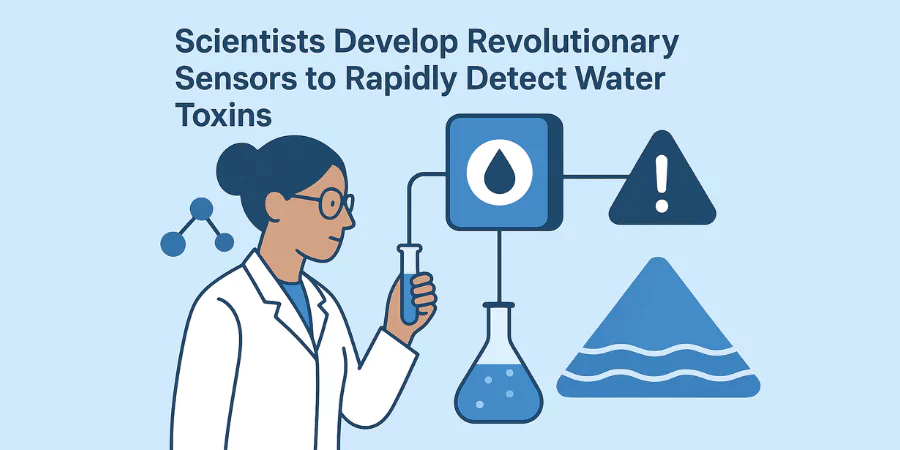Clean drinking water just got safer thanks to groundbreaking sensor technology that can detect dangerous contaminants in minutes rather than weeks. Scientists have unveiled innovative detection systems capable of identifying toxic “forever chemicals” and heavy metals at remarkably low concentrations, potentially transforming how communities monitor water safety.
These advances come at a critical time. Millions of Americans unknowingly consume water contaminated with harmful substances that traditional testing methods struggle to detect quickly or affordably. The new sensors promise to change that reality.
Game-Changing PFAS Detection Technology
Researchers at the University of Chicago Pritzker School of Molecular Engineering and Argonne National Laboratory have developed a portable sensor that detects per- and polyfluoroalkyl substances (PFAS) at astonishing sensitivity levels. Published in Nature Water, the device can identify these notorious chemicals at concentrations as low as 250 parts per quadrillion—comparable to finding a single grain of sand in an Olympic-sized swimming pool.
“Existing methods to measure levels of these contaminants can take weeks, and require state-of-the-art equipment and expertise,” explained Junhong Chen, Crown Family Professor at UChicago and Lead Water Strategist at Argonne National Laboratory. “Our new sensor device can measure these contaminants in just minutes.”
Why PFAS Detection Matters
PFAS chemicals have earned the nickname “forever chemicals” because they don’t break down naturally in the environment. Found in nonstick cookware, fast food packaging, and firefighting foam, these substances accumulate in human bodies over time. Medical research has linked PFAS exposure to serious health problems including various cancers, thyroid disorders, and compromised immune function.
The EPA recently proposed limiting toxic PFAS like perfluorooctanoic acid (PFOA) and perfluorooctanesulfonic acid (PFOS) to just 4 parts per trillion in drinking water. Meeting this standard requires detection capabilities that most communities currently lack.
From Trash to Treasure: Plastic Bags Detect Heavy Metals
Indonesian scientists at Universitas Gadjah Mada have achieved another remarkable breakthrough by converting discarded plastic shopping bags into glowing carbon quantum dots that detect toxic metals in water. Dr. Indriana Kartini’s research team developed a 10-hour process that transforms polyethylene plastic waste into highly sensitive nanomaterials.
These carbon quantum dots detect iron contamination at concentrations as low as 9.50 micromolar. The nanoparticles glow under UV light when they bind to metal ions, providing an immediate visual indicator of water contamination. The technology achieved a quantum yield of 10.04%, demonstrating strong luminescence suitable for practical sensing applications.
Artificial Intelligence Enhances Accuracy
Both detection systems harness artificial intelligence to maximize precision. The University of Chicago team employed machine learning to design molecular probes that selectively bind to specific PFAS chemicals, even when other contaminants exist at much higher concentrations. Their sensor measures changes in electrical conductivity across a silicon chip when PFAS molecules attach to specialized probes.
This AI-powered selectivity solves a major challenge in water testing: distinguishing target contaminants from the complex mixture of substances naturally present in water supplies.
Real-World Testing Confirms Reliability
The PFAS sensor has been validated against EPA-approved laboratory methods and maintains accuracy through multiple detection cycles. This durability suggests the technology could enable continuous, real-time water monitoring at treatment facilities or even in individual homes.
Chen’s team plans to expand their platform to detect additional contaminants, including antibiotics and viruses in wastewater. Such versatility could make the sensor a comprehensive water safety tool rather than a single-purpose device.
A New Era in Water Safety Monitoring
These developments represent more than incremental improvements in existing technology. They fundamentally change what’s possible in water quality monitoring by combining ultra-sensitive detection capabilities with portable, affordable designs.
Communities no longer need to wait weeks for laboratory results or invest in expensive equipment to assess drinking water safety. Individual households could potentially test their own water with these emerging technologies. As these sensors move from research laboratories to practical deployment, they promise to protect public health by catching contamination problems before they cause widespread harm.
The convergence of nanotechnology, artificial intelligence, and innovative materials science is delivering tools that make invisible threats visible. For millions concerned about what’s in their drinking water, that visibility could prove life-saving.













